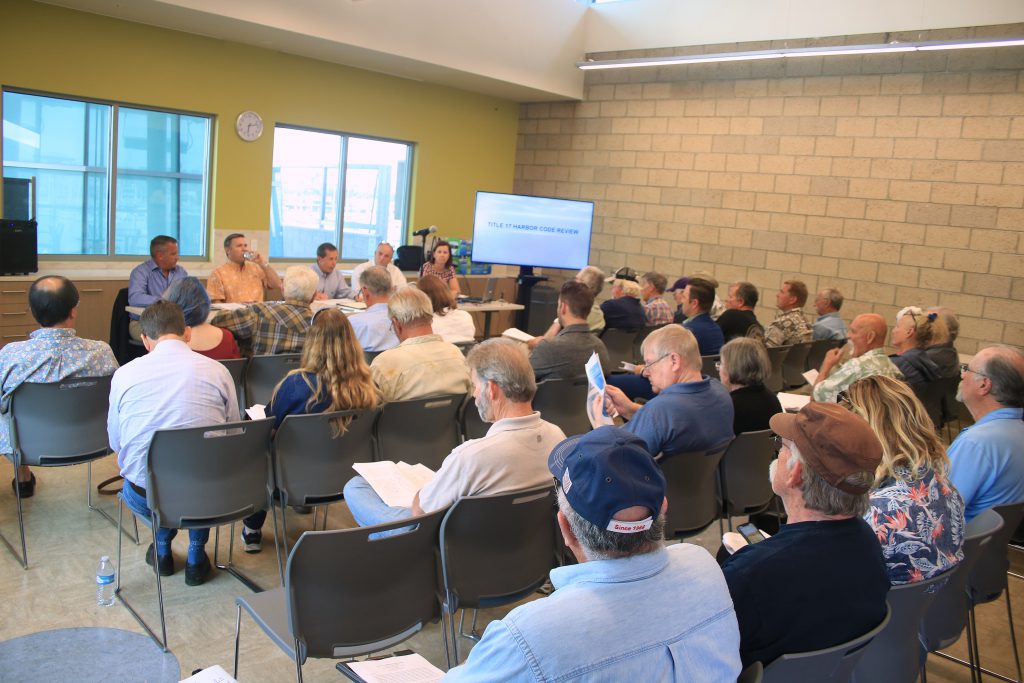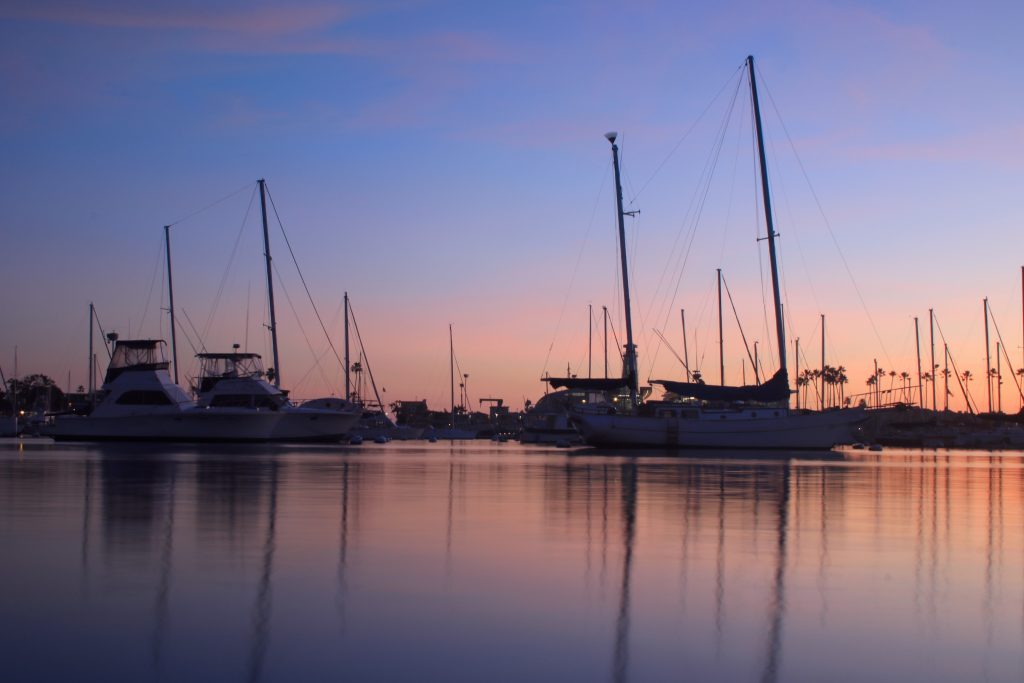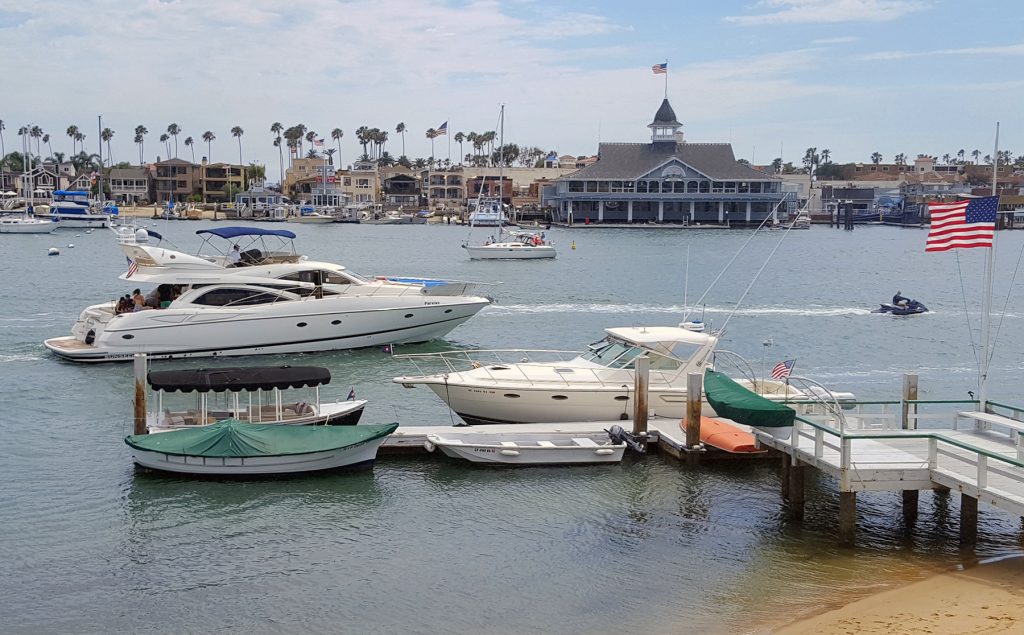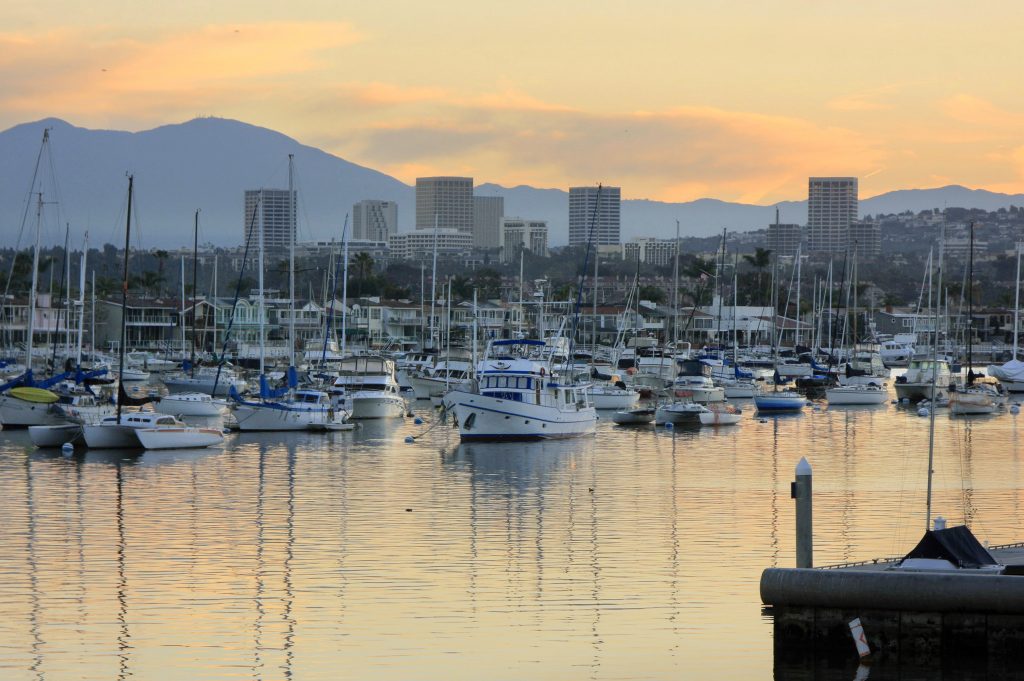
— Photo by Sara Hall
A lot of opinions, ideas, and concerns were shared by boaters, marine-related business owners, and mooring permitees during the first public forum for the Newport Beach Title 17 Harbor Code review this week.
As part of their ongoing effort to update the city’s Harbor Code, Harbor Commissioners and city staff hosted the community meeting Monday to gather input from the community.
About 50 people packed into Little Balboa room at Marina Park on the Balboa Peninsula to discuss issues related to the code that governs Newport Harbor.
The Ad-Hoc Committee tasked with reviewing Title 17, and holding several community meetings in the process, consists of Harbor Commission Chair Bill Kenney and commissioners Paul Blank and Don Yahn. Harbormaster Kurt Borsting and Assistant City Manager Carol Jacobs also helped run the meeting on Monday.
Monday was the first of several meetings, Kenney explained. It’s a “daunting task,” he said.
“This is a good discussion, that’s why we’re here,” Kenney said. “We will consider each and every comment.”
The public is invited to voice their opinions at the Harbor Commission and City Council meetings as well, he added.
“Our only focus here is to listen to you,” Jacobs said. “We want to hear everything that you have to say.”
On Monday, the sections reviewed were: 17.01 Definitions; 17.05 General Provisions; 17.20 Vessel Launching and Operations; 17.25 Berthing, Mooring and Storage; 17.30 Harbor Use Regulations; and 17.35 Harbor Development Regulations.
These same sections will be discussed at another community meeting on May 6, and then any proposed changes will be considered by the Harbor Commission on June 12 and by the City Council on July 9.
“We’re going to go through Title 17 page by page, we’re going to review each section individually, starting at the very beginning,” Kenney said.
Because of the “magnitude” of the process, they split Title 17 up between the meetings, Kenney explained.
At public meetings on May 13 and June 24, the Harbor Commission on July 10, and City Council on Aug. 13, the remaining topics will be reviewed: 17.40 live-aboard, 17.45 sanitation, 17.50 harbor development permits, 17.55 dredging, 17.65 appeals, and 17.70 enforcement.
The liveliest discussion on Monday came during the review of chapter 17.25, berthing, mooring, and storage. An entirely new section is proposed regarding time limits on public docks, piers, and harbor facilities.

— NB Indy file photo ©
Those areas are not intended for long-term vessel storage, the recommended new section explains.
“As such, vessels tied up or secured in marked areas designated for either 24 hours or 72 maximums may not continue to use that same dock area beyond those established periods by relocating the vessel to another section of that dock, or securing the line associated with that vessel to another tie off location on that dock,” the draft text reads.
The proposed code requires vessels in those time limited areas be removed from that pier, dock or facility for a minimum of 24 hours before returning.
The new language is aimed at people who tie their vessel up in a 72-hour area, then just move it a few feet after the time limit is up, but still occupy space at the same dock. Some boaters have complained that some vessels, usually dinghies or shore boats, are left for days, weeks, or even months in these time-limit spaces.
“That’s not the purpose of (those areas), it’s a shared resource,” Jacobs said.
Although there was some concern about how the code was written and that it doesn’t address the root of the issue: Enforcement.
Kenney encouraged people to email their concerns and ideas to the Title 17 email address.
“Why don’t those of you that are impacted give a shot at giving us your version of this paragraph?” Kenney asked, an idea several audience members liked.
It could be a problem for people who visit the harbor every couple of days to work or stay on their boat for a few hours before heading back home, and if they can’t tie their dinghy back up to that same dock and can’t get a ride in to shore, they’re stuck, explained one boater.
“The way this is written is totally, absolutely unworkable,” said another commenter.
The issue is enforcement, he added, a sentiment several others, including Harbor Commissioners, have agreed with.
“Enforcement takes dollars,” Kenney said. “We’ve been pushing the Council to allocate more money so that we can have a bigger staff in the Harbor Department so that we can enforce all of these regulations.”
Kenney encouraged the audience to also contact City Council.
Jacobs explained that the Harbormaster team is currently working on an enforcement plan focusing on time limits, which includes photographing and tagging boats with time notices and educational documents and signage.
The goal is to get the people who are essentially storing their vessels at those docks and piers “out of there,” Jacobs said.

— Photo by Sara Hall ©
Jacobs praised the plan and Borsting for his work on it. She takes exception to people saying the city is ignoring the issue, she added.
“It takes a long time to take care of an asset that has been ignored for decades,” Jacobs said, “and we are trying to do that.”
Borsting understands the process and codes, Jacobs said, and they can really focus on fixing it. They are trying to do it in a friendly and thoughtful way, Jacobs continued, so people understand the enforcement.
Several people also supported Borsting’s question about adding a 12-hour time limit space.
Also during the Monday meeting, there were a few highlights during the discussion of definitions, the most notable conversation centered around graywater.
The definition for graywater is a proposed new addition to the Harbor Code.
The suggested new language: The term “graywater” shall mean all water and other fluids used on a vessel for any purpose whatsoever, including but not limited to, 1) that used for washing or cleaning clothing, linens, towels, bedding, and other linens; 2) that used for cooking equipment and eating utensils, and serving ware; 3) that used for bathing, showering and cleansing; 4) that used for washing and/or cleaning all or any portion of the vessel, including but not limited to, heads, kitchens, engine room, floors, windows, furniture, equipment and other portions of the interior of the vessel.
It is illegal under federal law to dump black water, or raw sewage discharge, into navigable U.S. waters, including coastal waters within three miles of shore.
There are currently no restrictions in the municipal code about dumping graywater in Newport Harbor, Jacobs explained.
“In my opinion, a private boat can dump certain portions of graywater,” Kenney said.
One public commenter said he was “shocked” that was currently the case.
This is just the definition of the word, Kenney emphasized, any restrictions on what is and isn’t allowed regarding graywater is dealt with in another section of the code.
Charter boats, as part of the requirements to obtain a Marine Activities Permit, have to capture and properly dispose of their graywater, Kenney clarified.
Addressing a few concerns raised by residents, Kenney said he doesn’t think there are any references to a private vessel being required to capture graywater in the code.
If that is the case, another boater in the audience suggested the definition for graywater clarify that it applies to references mentioned in the requirements for the MAP.
“Our concern is that you’re slipping in a definition here that might affect the normal use of our (private) boats, private,” one commenter noted. “This could be a slippery slope that would erode the use and enjoyment of our boats in ways that you don’t really intend.”

— Photo by Christopher Trela ©
A little graywater from a boat is nothing compared to the pollution being washed down from land, another pointed out, with several others audibly agreeing.
There were a few other definitions that prompted conversation on Monday.
The ad hoc committee suggested defining a live-aboard as someone who stays overnight on a vessel for more than 11 days, a significant increase from the current 72 hours, over a 30-day period. Public commenters asked for 12 days per month, which several claimed is closer to the standard.
Another proposed change included adding to the definition of “operable” so that it clarifies that the vessel must maneuver “safely and consistently” under its own power.
A noteworthy discussion during the definitions review revolved around what process to use for vessel length, focusing mostly on length overall or documented length. Kenney asked the Mooring Association to consider the issue and weigh in on the matter.
There was also quite a bit of discussion about vessel launching and hauling, in chapter 17.20.
The section currently states that launching is only allowed where permitted. “No person shall launch or remove any vessel from the waters of Newport Harbor over any public seawall, sidewalk, street end or public property, except at locations where a regular business, as authorized under Title 20, of launching and hauling vessels is conducted or at launching sites designated by resolution of the City Council.”
A proposed change expands the hours allowed to use the designated launch areas, suggested to start at 7 a.m. (an hour earlier than the current start time) and closing at sunset (rather than the current 8 p.m.).
Another recommended change includes removing “trailers, dollies, rollers” as devices that are not allowed to be used for purposes of launching vessels or transporting them on beaches. With the recommended changes, the line is shortened to state that “no mechanical devices may be used” for launching.
This is a “great” modification, commented one resident at the meeting.
Some people need dollies, but they don’t want tractors on the beach, a few joked.
This section of the code should be less restrictive, another resident noted.
“You have an opportunity to make this work better for everyone,” said longtime resident Carter Ford of the Newport Mooring Association. This change is a step in the right direction, he added.
Several people mentioned the need to be more launch areas.
Section 17.05, general provisions, has no proposed changes and the public had no comments on Monday.
For more information, visit newportbeachca.gov/government/departments/harbor/harbor-commission/title-17-update, email title17review@newportbeachca.gov, or call the Harbor Department at (949) 270-8159.

— Photo by Sara Hall ©




